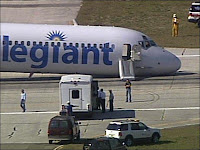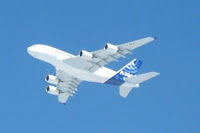
The U.S. National Transportation Safety Board (NTSB) is sending a team to Indonesia to assist with the investigation into the cause of the
crash of a Boeing 737-400 operated by Garuda Indonesia. In addition to NTSB personnel, the American team will include representatives from the Federal Aviation Administration (FAA) and the Boeing Company.
Garuda Flight 200
overran the runway at Yogyakarta after arriving from Jakarta. It reportedly broke through a fence, crossed a road, and came to rest in a rice paddy. The aircraft was destroyed by fire after the crash.
While there have been conflicting reports in the various media about exactly how many survived the crash and how many were lost, an NTSB press release that I received via email now puts the number at 21 fatalities and 50 serious injuries. Among those injuries were burns and broken bones, according to reports published in various news outlets.
Here is some of what a report on
CBS News says:
Alessandro Bertellotti, a journalist with Italian broadcaster Rai, said the plane was going at a "crazy speed" as it approached Yogyakarta airport after a 50-minute flight from the capital, Jakarta.
"It was going into a dive and I was certain we would crash on the ground," he told the Italian news agency ANSA. "I was sitting behind the wing. I saw that the pilot was trying to stop it, but it was too fast. It literally bounced on the strip."
...
Wayan Sukarda, an Indonesian cameraman for Australia's Seven Network, managed to scramble off the plane, then shot dramatic video of dazed passengers fleeing as smoke poured from the fuselage. An explosion and fireball then ripped through the air, apparently as the fire reached a fuel tank, the footage showed.
Sukarda had called the network as the plane was crashing, a colleague told The West Australian newspaper. "He was screaming, 'The plane's crashing.' I thought he must have seen another plane crash. I didn't know it was the one he was on. You could hear all the alarms and sirens going off, people screaming," said Channel Seven's Danny Sim.
The video shot on the scene by Sukarda has been posted on the
CBS News website.
Here's the link to the video. (Be patient -- you have to sit through a commercial message before the accident footage appears!)
BBC News has a
collection of still photos of the crash site on its website.
The crash is big news in Australia since there were a number of Australians aboard the flight, some of whom are believed to be among the fatalities. At least two Australians were severely injured and have been evacuated from Indonesia,
according to a story on Australia's
ABC News Online.
Almost every news outlet that I've seen has published comments and speculation about the cause of the crash, made by surviving passengers or observers in Yogyakarta. Most seemed to say that the aircraft "shook" or "shuddered" just before it landed, and that it bounced after it touched down. Eyewitnesses and passengers also claimed that it was "coming in too fast."
A gentleman by the name of Robert Heath, identified variously as an 'aviation expert' or a 'crisis management expert,' is being quoted widely about the accident by the Australian media. Apparently he also believes that excessive speed on landing may have figured into the accident.
University of South Australia associate professor Robert Heath said the Garuda flight appeared to land intact and said the fire that then engulfed it may have been caused by an engine break-up or a puncture to a fuel tank.
"From what I can see so far the aircraft appeared to land intact and that may point to excess speed being a factor," Professor Heath said.
"The fire may have been caused by the nose wheel hitting things as it ran off the runway or engine destruction.
"It was probable that a fuel tank was punctured on impact."[news.com.au]
That same article also said that Indonesian President Susilo Bambang Yudhoyono has ordered that the accident investigation include "the possibility of 'nontechnical' causes - an apparent reference to sabotage."
Here is more commentary from Professor Heath:
"The key questions here are how soon did the aircraft catch fire and how soon were rescuers able to get there," he said.
"The fact that the structure was intact also meant the only escape routes were through the doors rather than other holes in the structure.
"This means less chance for people to escape the toxic fumes and lack of oxygen, which are the main reasons most people die rather than being killed by the flames themselves."
Prof Heath said it did not appear that weather conditions were a factor in the crash but it shouldn't be assumed it was caused by pilot error.
"There are a number of other factors such as runway conditions, weight of the aircraft, tyre burst or jamming of controls for some reason that would also have to be considered," he said.[The Australian]
What about the condition of the runway? I have heard privately from pilots who say that the runway at Yogyakarta is quite bumpy, and that its condition may have deteriorated further due to recent earthquakes in the area.
Australian media are reporting that investigators at the crash scene have recovered "the black box" from the aircraft wreckage. They don't specify whether that is a Flight Data Recorder or a Cockpit Voice Recorder, but in any case let's hope that some useful information can be retrieved from the device.
 On March 29, 2007 an ATR-72 aircraft operated by Vietnam Airlines made an emergency landing at Tan Son Nhut airport after experiencing hydraulic problems. News reports about the incident say that the aircraft touched down safely, but then slid into the grass beside the runway. No one was injured.
On March 29, 2007 an ATR-72 aircraft operated by Vietnam Airlines made an emergency landing at Tan Son Nhut airport after experiencing hydraulic problems. News reports about the incident say that the aircraft touched down safely, but then slid into the grass beside the runway. No one was injured.


























